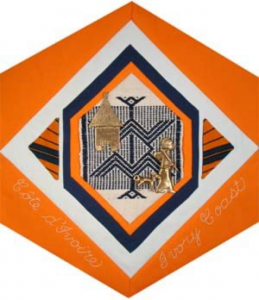Côte d’Ivoire

The Block
The people of Côte d’Ivoire view textiles and the decorative arts as works of art as well as a form of social communication. Strip-cloth weaving in particular is a traditional method practiced in West Africa in which village men produce long, narrow strips of cloth using small hand looms. These strips are then sewn together to create larger items, such as clothing, tablecloths, and bedding. A sample of this weaving, donated by Hawaba Kebe, makes up the centre of this block. It is worked in the traditional colours of blue and white and features a typical geometric design, symbolizing a ‘colon’ or cowrie shell. Cowrie shells are also frequently used to decorate the headdresses worn at festivals. The motif is framed in a rectangular pattern, which is introduced at either end by a longangun (an arrow-like design that represents the talking drum). The weaving is enhanced with miniature bronze casts of a typical hut and villager. Each bronze was created using the traditional, but complicated, method of lost wax or cire-perdue, which has existed for at least 5,000 years. Two corner pieces of African wax-resist fabric complete the block.
Cultural Profile
Formerly a French colony in West Africa, Côte d’Ivoire is a smaller country consisting of three principal geographic regions: the Lagoon Region, which is fringed by sandy beaches, the Central Forest Belt, and the upland savannahs. Previously known as ‘Ivory Coast’ because of the large number of elephants inhabiting the area, its official name became Côte d’Ivoire in 1986. The country is the world’s largest producer of cocoa, and the fourth largest producer of coffee. It is also the site of the world’s largest Christian church, Our Lady of Peace of Yamoussoukro Basilica, which stands 149 metres high, seats 7,000 people and has an open-air area for over 200,000 more people.
Côte d’Ivoire’s ethnically diverse population is comprised of more than 60 tribes, each traditionally independent from the other and each having tribal affiliations with larger groups outside the borders of the republic. The principal groups include Akan, Kru, Voltaic, Dan, and Mandinka (also known as Mandingo or Malinke). In addition, there are small French and Lebanese communities. The official language is French, understood by about 70% of the population, although there are also about 60 native dialects, of which Dioula is the most widely spoken.
The more modernized sectors of Côte d’Ivoire have been greatly influenced by French customs. However, indigenous culture remains strong and is well-known for its artistic creations, in particular ceremonial masks carved by the various tribes. The country is also renowned for its gold jewelry making, wooden sculptures and acrobatic dances such as stilt-dancing,
Textiles in the country range from the strip-cloth are shown on the block to korhogo cloth, made by the Senufo people who use mud to paint designs of animals, people or geometric shapes on white woven strips, resulting in patterns in tones of black, brown and gray. Kente cloth, a colourful fabric featuring geometric designs, is also woven by the Akan people in the South. The Guro people also have a strong weaving tradition, producing indigo dyed cloth as well as red and white cotton. These weavers delicately carve the pulleys on their looms so that, while they work, in the words of one weaver, ‘it is pleasant to look at something nice when you work’. Weaving is traditionally done by men in all tribes of Cote d’Ivoire. Like many West Africans, Ivorians love wax-resistant cottons.
Immigration records indicate that people have been coming to Canada from Côte d’Ivoire since 1974 (the year individual countries began to be listed instead of regional designations), often for political or economic reasons. Most settled in Québec because of the French language, and while the numbers of Ivorians is small, listed at just over 5,000 in 2011, the general African influence on Canadian society is felt in many areas including music, art and cuisine.
